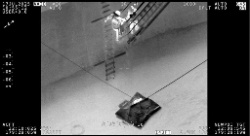Pollard and NZWBMS re PCE report on 1080
Joint press release by Dr J.C. Pollard and New Zealand
Wildlands Biodiversity Management
Society.
How the Parliamentary
Commissioner for the Environment’s assessment of 1080
poison misled Parliament and New Zealanders
New Zealand has an extraordinary culture of toxin use. Our own environmental watchdog, the Parliamentary Commissioner for the Environment (PCE, Dr Jan Wright) declared in June that we need to spread more 1080 poison aerially across native forests to save birds, and that we need it to help the dairy and forestry industries too.(1) Signs warning of cyanide, pindone and 1080 poison are a standard feature in rural areas. Public notices warn of diquat operations in lakes, and contractors spray broad-spectrum herbicides across our precious braided riverbeds.
Those with vested interests (the Animal Health Board (AHB), Department of Conservation (DoC), Regional Councils and their contractors), and the peculiar breed of greenie who thinks that we should rid the country of every imported species at any cost (seemingly Forest & Bird and Green Party members), defend 1080 poison fervently; as a perfect broad spectrum, non-selective poison, albeit a crude and dangerous tool, with which to achieve their aims. However people who wish to learn about 1080 poison will find misreported facts, wilful blindness and an appalling lack of research supporting its use.
“Another scientist in Dunedin and I independently discovered the horrors of 1080 when we read the material collected by ERMA for its evaluation of this poison in 2007”, said Dr J.C. Pollard. “Unknown to each other, we each embarked on a project that was huge and time-consuming, determined to get this information in front of other members of the public. My project consisted of an ‘index’ of 1624 quotes straight from the documents that ERMA’s Agency used, divided into 49 topics (e.g. biodegradation, invertebrates, frogs, Tb).(2) At the end of each topic, quotes from the ERMA Committee’s Decision show its clear bias towards 1080 use, despite obvious risks and an almost complete lack of data. Alexis Pietak’s project(2) was a brilliant review of the research on 1080, showing its bias and lack of validity, and the death records of native birds that show insectivores, omnivores and carnivores are especially vulnerable to 1080 poison.
Meanwhile in the North Island, scientists Pat and Quinn Whiting-O’Keefe had embarked on their own crusade to educate the public that research needed to have some scientific merit and DoC’s research on 1080 had none whatsoever.(2)
“Our work has been embraced by the anti-1080 community but among the general public there is a tendency to believe the PR from DoC and AHB fed to the media”, said Dr Pollard. This is hardly surprising given that the trusting public are likely to have faith in government departments, especially one with high profile, professional publicity campaigns.
Mr Graham A. Sperry, speaking on behalf of the NZ Wildlands Biodiversity Management Society (NZWBMS) agrees and expressed the opinion that “Many concerned public consider parts of the government as bordering on disreputable because of the activities of DoC and the AHB with regard to poison use.” He gave as an example “The AHB is allocated tens of millions of dollars of public funds each year, and yet they were set up as a Charitable Society which is not a government entity, and as such are not required to reveal any details of their costs. Contractors who are hired by the AHB directly or indirectly through contracting regional councils have been accused of disguising compensatory payments resulting from incorrect applications of poison”, said Mr Sperry. “Obfuscation of cost reporting may be the reason why the PCE report is so misleading in its comparisons of aerial 1080 poisoning to alternative ground based methods” he said.
Mr Sperry was emphatic that “the exemptions, for more than a decade, of the AHB, even though funded by the public purse, from answering enquiries made under the provisions of the Official Information Act, coupled with it also being exempted from investigation by the Ombudsmen have led the public and the NZWBM society to conclude the AHB has plenty to hide. The mistrust of the AHB and the successive governments which created and protect it from public scrutiny has grown particularly since the ERMA review of 1080 in 2006/7”, he said. Mr Sperry made a further comment that “The PCE report specifically excluded investigating several important issues, including most of the AHB activities involving 1080 poison, even though the AHB is the major user, especially on DoC’s public lands, Forest Parks and National Parks”. In the introduction to the report it was stated that “This report does not cover the AHB’s actions in controlling bovine tuberculosis (TB) in any detail”. Also lacking is adequate recognition of the substantial cost recovery available for ground based control through fur and meat harvesting.
Meanwhile, DoC’s claims about the benefits of 1080 are wishful thinking, not borne out by research. Here’s an example. In an assessment of a 51, 000 ha planned aerial drop of pindone and 1080 to kill rabbits in South Canterbury, the DoC manager wrote: “The disturbance of ‘normal’ predator-prey relationships between the introduced and native fauna of the control area...is not clearly understood in terms of cause and effect but the overall net effect on the ecosystem is one of profound benefit due to the successful control of rabbits” (DoC, 2008). However, there was no sign of this hoped-for benefit when research was carried out by Landcare: “Our hypothesis that rabbits reduce the abundance of ground fauna by reducing vegetation, and by providing prey for mammalian predators (cats and ferrets) that consume ground fauna as secondary prey, was not supported” (Norbury et al., 2009). What a shame the Government did not think instead to support the growing rabbit-based industry in this area. At least four major companies are using South Canterbury rabbit meat to supply domestic and overseas markets.
Dr Pollard went on to say “Dr Wright’s assessment of 1080 poison is merely a collection of these wishful DoC thoughts and when you examine the studies she cited to back them up you find that NZ ecologists tell a far different story”(2) . “Dr Wright ignored their repeated warnings that aerial 1080 results in increased numbers and impacts of rats and other invasive feral species, including cats and stoats. She failed to note that the studies showed it was more effective to use continuous control and a variety of ground based techniques to control rats and stoats, than aerial 1080. Her cited papers failed to support her claim that 1080 poison was beneficial to bird populations, and even the studies on trees failed to show much or any benefit from possum control (with some negative effects, e.g. reduced fruitfall (attributed to rats) and the death of mistletoe plants). She didn’t admit that there was so little information on effects of 1080 on native frogs and reptiles that ERMA was unable to assess the risks. Or that the very small amount of information on aquatic environments, invertebrates, plants and micro-organisms indicates that 1080 may have severe effects on them.”
Dr Pollard continued; “I suspect the PCE didn’t even read Suren & Lambert’s (2006) study that she used to claim 1080 had not harmed populations of freshwater fish. In fact the study was unable to conclude anything about populations of fish. The study was on the impact of 1080 leaching from baits in bags 10m and 100m upstream from cages containing fish. During the experiment some of the cages were stolen, many fish escaped, and deaths were blamed on high rainfall. Overall there was no evidence of an effect of the leached 1080 on the caged fish; but the researchers did find effects of the leached 1080 on freshwater invertebrates, which they decided to discount as not being ‘ecologically significant’.”
“Another paper I think the PCE must have left it up to staff to read was the one used to claim that scientists had assessed 1080 as being ‘moderately humane’ (Beausoleil et al., 2010)”, said Dr Pollard. “This is quite misleading because 1080 is a very cruel poison. In the report cited, the scientists actually said that the word ‘humaneness’ should be replaced with ‘animal welfare impact’ because truly humane control methods are rare. It stated that 1080 had a severe to extreme impact lasting for hours, and because of this it was rated as ‘intermediate’ between cyanide (which causes rapid loss of consciousness and death) at one end of the scale and anticoagulants such as brodifacoum (which has a severe to extreme impact for days to weeks) at the other end. Having an intermediate impact does not amount to being moderately humane.”
Again the PCE’s claim that we “do not need more water samples” is naive. A reliable method for assessing 1080 contamination of water supplies has not been used historically, as noted by ERMA. Such a method should be identified and used extensively because of the risk to human health and exports: 1080 is known to spread uncontrollably and to pass into both meat and milk, and to persist chronically, for example in dry environments and in carcasses. In mammals, sub-lethal doses of 1080 cause birth deformities, reproductive disorders and damage the heart and other organs. Claims that 1080 does not cause cancer come from a single study on mutation in mice, of which ERMA was unable to get a full copy.
The PCE glossed over the use of 1080 in Tb control, stating only that it would be much more difficult and expensive without it. However research shows that ground control of wildlife Tb carriers is likely to be more effective in protecting dairy herds than aerial poisoning of possums(2). With ground control, Tb can be monitored and targeted in the full range of species affected and specifically where it places livestock at risk. The carcasses of infected pests, a potential source of infection for remaining wildlife, can be removed. Farm boundaries, and our commercial exotic forests are normally readily accessible for ground control of pests without the need for aerial broadcast poisoning.
Dr Pollard, The NZ Wildlands Biodiversity Management Society and many citizens opposed to the use of 1080 and other broad-spectrum poisons contend that the use of aerial 1080 should be stopped until there is compelling evidence that it is not damaging our native ecosystems or causing health problems. Considering the scale of the risk this practice imposes, valid research demonstrating clear benefits would be expected to underlie its on-going use. “The PCE did not manage to find such research. In fact she found so little substance she was forced to call her assessment ‘not overly technical’” said Dr Pollard.
The facts need to be out and for this reason scientists such as Drs Pollard, Pietak, and Whiting-O’Keefe, and groups like NZWBMS continue to expose them.
A formal complaint about the misleading content of the PCE report was jointly presented by the NZWBMS and Dr Pollard to The Speaker of the House of Representatives and copied to current Parliamentary party leaders, The Executive Committee secretary and to His Excellency The Governor General, on 25th October 2011, requesting that the report be declared invalid in its current form. This action has been necessary because The Ombudsmen are excluded from investigating the PCE and it is the office of The Speaker who authorises the fiscal requirements of the PCE.
(1) PCE, 2011. Evaluating the use
of 1080: Predators, poisons and silent forests.
Parliamentary Commissioner for the Environment, Wellington.
85 pp. Available at www.pce.parliament.nz
(2) These
documents, and references cited, are at
www.1080science.co.nz
ENDS


 Gordon Campbell: On The Costs Of Regulating Cost, And Burkina Faso As A Role Model
Gordon Campbell: On The Costs Of Regulating Cost, And Burkina Faso As A Role Model Dog Lovers of Monte Cecilia: Locals Challenge Puketāpapa Local Board And Auckland Council’s On-Leash Policy Change For Monte Cecilia Park
Dog Lovers of Monte Cecilia: Locals Challenge Puketāpapa Local Board And Auckland Council’s On-Leash Policy Change For Monte Cecilia Park Maritime New Zealand: Three Rescued In High-Seas Operation After Vessel Abandoned North Of New Zealand
Maritime New Zealand: Three Rescued In High-Seas Operation After Vessel Abandoned North Of New Zealand Health Coalition Aotearoa: Experts Urge Fix As Government Expands Failing Lunch Scheme To Primary Schools
Health Coalition Aotearoa: Experts Urge Fix As Government Expands Failing Lunch Scheme To Primary Schools Helen Clark Foundation: The Helen Clark Foundation Launches Honorary Fellow Programme
Helen Clark Foundation: The Helen Clark Foundation Launches Honorary Fellow Programme Department of Conservation: Call For Public Information On Auckland Marine Mammal Cases
Department of Conservation: Call For Public Information On Auckland Marine Mammal Cases New Zealand Jewish Council: NZ Jewish Council Clarifies Position - Advocating For Safety And Accountability, Not Censorship
New Zealand Jewish Council: NZ Jewish Council Clarifies Position - Advocating For Safety And Accountability, Not Censorship


